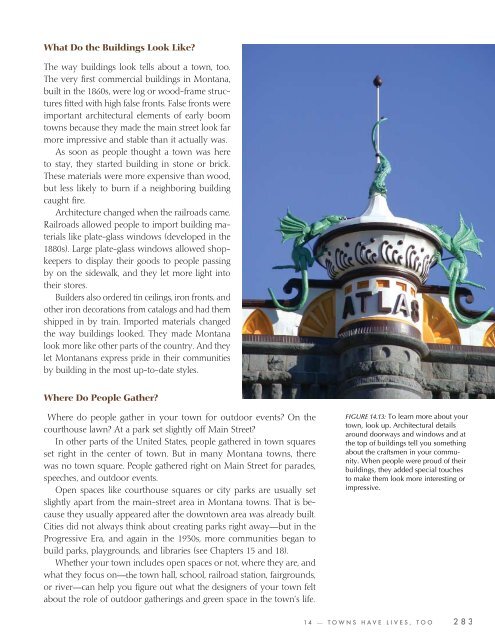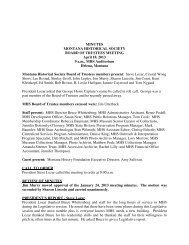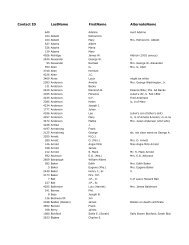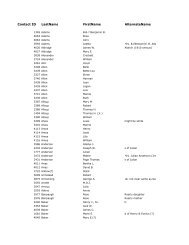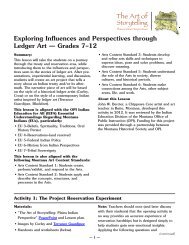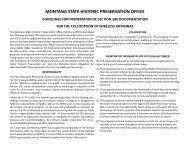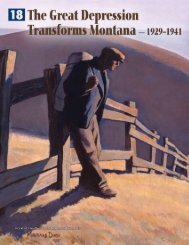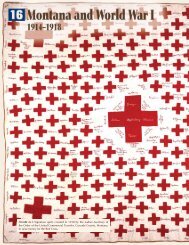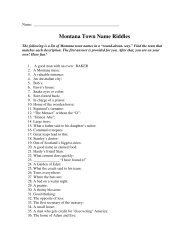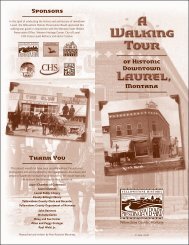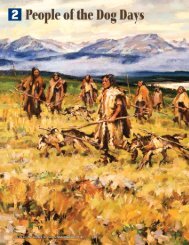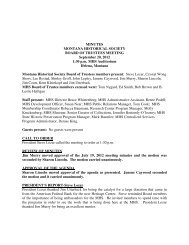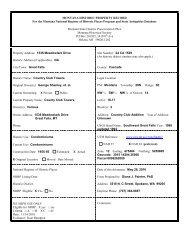Great Falls Montana: Its Situation, Surroundings - Montana Historical ...
Great Falls Montana: Its Situation, Surroundings - Montana Historical ...
Great Falls Montana: Its Situation, Surroundings - Montana Historical ...
You also want an ePaper? Increase the reach of your titles
YUMPU automatically turns print PDFs into web optimized ePapers that Google loves.
What Do the Buildings Look Like?<br />
The way buildings look tells about a town, too.<br />
The very fi rst commercial buildings in <strong>Montana</strong>,<br />
built in the 1860s, were log or wood-frame structures<br />
fi tted with high false fronts. False fronts were<br />
important architectural elements of early boom<br />
towns because they made the main street look far<br />
more impressive and stable than it actually was.<br />
As soon as people thought a town was here<br />
to stay, they started building in stone or brick.<br />
These materials were more expensive than wood,<br />
but less likely to burn if a neighboring building<br />
caught fi re.<br />
Architecture changed when the railroads came.<br />
Railroads allowed people to import building materials<br />
like plate-glass windows (developed in the<br />
1880s). Large plate-glass windows allowed shopkeepers<br />
to display their goods to people passing<br />
by on the sidewalk, and they let more light into<br />
their stores.<br />
Builders also ordered tin ceilings, iron fronts, and<br />
other iron decorations from catalogs and had them<br />
shipped in by train. Imported materials changed<br />
the way buildings looked. They made <strong>Montana</strong><br />
look more like other parts of the country. And they<br />
let <strong>Montana</strong>ns express pride in their communities<br />
by building in the most up-to-date styles.<br />
Where Do People Gather?<br />
Where do people gather in your town for outdoor events? On the<br />
courthouse lawn? At a park set slightly off Main Street?<br />
In other parts of the United States, people gathered in town squares<br />
set right in the center of town. But in many <strong>Montana</strong> towns, there<br />
was no town square. People gathered right on Main Street for parades,<br />
speeches, and outdoor events.<br />
Open spaces like courthouse squares or city parks are usually set<br />
slightly apart from the main-street area in <strong>Montana</strong> towns. That is because<br />
they usually appeared after the downtown area was already built.<br />
Cities did not always think about creating parks right away—but in the<br />
Progressive Era, and again in the 1930s, more communities began to<br />
build parks, playgrounds, and libraries (see Chapters 15 and 18).<br />
Whether your town includes open spaces or not, where they are, and<br />
what they focus on—the town hall, school, railroad station, fairgrounds,<br />
or river—can help you fi gure out what the designers of your town felt<br />
about the role of outdoor gatherings and green space in the town’s life.<br />
FIGURE 14.13: To learn more about your<br />
town, look up. Architectural details<br />
around doorways and windows and at<br />
the top of buildings tell you something<br />
about the craftsmen in your community.<br />
When people were proud of their<br />
buildings, they added special touches<br />
to make them look more interesting or<br />
impressive.<br />
1 4 — T O W N S H A V E L I V E S , T O O 2 8 3


